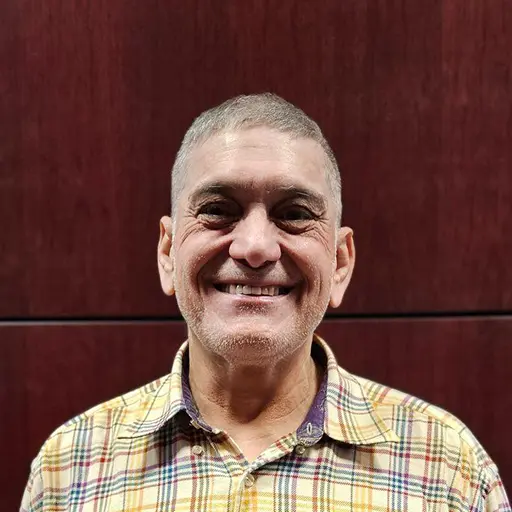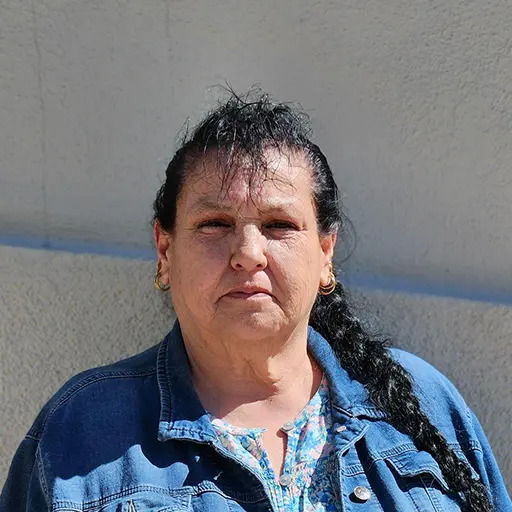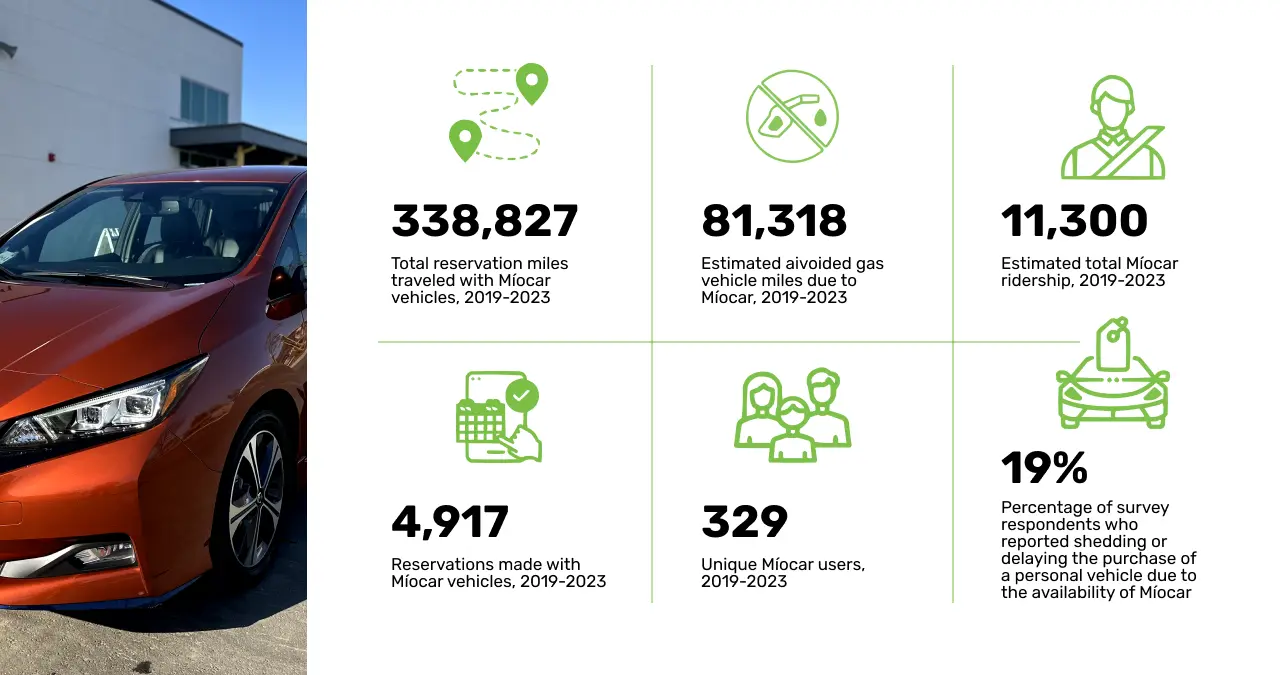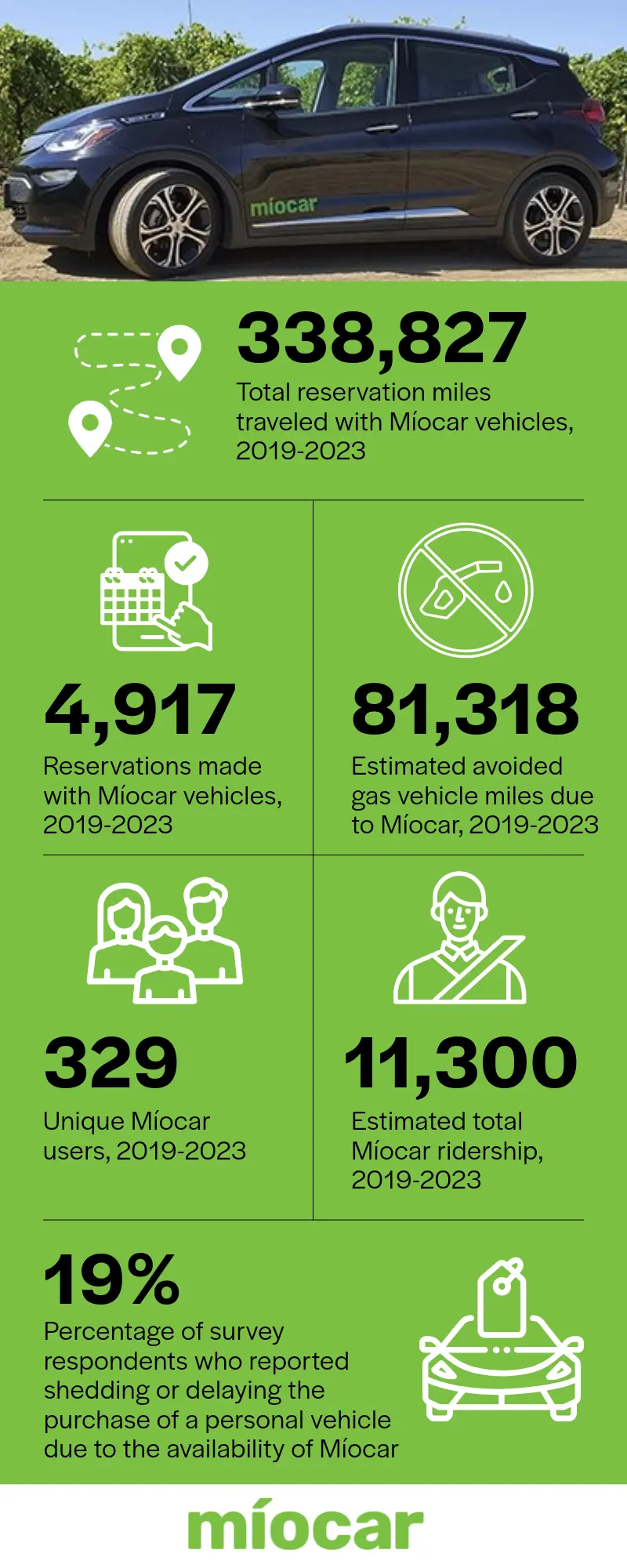This dashboard is a collection of information about how electric vehicle (EV) carsharing has been successfully implemented in California to improve the mobility of individuals and communities. The site includes background information on EV carsharing, findings from evaluations of Miocar EV carsharing services, testimonials from carsharing members, and a toolkit of resources to be used by communities who are considering EV carsharing as a mobility solution.
What is EV carsharing?
Carsharing services allow people to rent vehicles for short periods of time, such as a few hours or a day. Carsharing services can be one-way, meaning that vehicles can be dropped off in a different location from where they are picked up, or round-trip, meaning that the pickup and dropoff location must be the same. Cars are typically picked up and dropped off at specified locations, called hubs, often located near housing developments or in areas central to a community. Electric vehicle (EV) carsharing services provide alternatives to conventional gas cars by using hybrid, plug-in hybrid, or fully electric cars.
What is Miocar?
This map displays Miocar hub locations and estimated service areas based on user home census tracts. Click on each zone to view information about each service area, such as number of carshare vehicles and users by year.
The research presented in this dashboard was conducted at the UC Davis Institute of Transportation Studies. This dashboard was funded by a grant from the National Center for Sustainable Transportation, supported by the California Department of Transportation (Caltrans).
Historical summary and current status
- – – – Service Launch in Tulare and Kern Counties
- – – – Service paused due to COVID-19 pandemic
- – – – COVID-19 pause lifted, service resumed
- – – – General Motors issued recall of Chevy Bolt vehicles, representing 17 of the 27 vehicle Miocar fleet
- – – – Richmond Service Launch
- – – – Stockton Service Launch
Below are testimonials, quotes, and stories collected by Miocar from users across its service areas.

Zack
“I almost exclusively just use Miocar to get around. You don’t have to worry about putting in gas, you just have to unplug it and go.”
Zack is from Stockton, CA and works in and around Stockton as an independent contractor. He lives in a household of four people who share one personal vehicle. He has been using Miocar since Fall of 2023.
“Before I was able to use Miocar my car was not the most reliable so I didn’t want to take it outside the Stockton or Central Valley area. Now that Miocar is available, I am able to drive to the Bay Area and I drive to San Jose now every Friday and Sunday using Miocar.
The only downside I could say is that you have to watch how far you can go on that electric charge. There are plenty of chargers around this area so that is not much of an issue.
At the cost of Miocar, it’s a lot cheaper per day to use that than to just run around on gas. Sometimes I would be spending $50-$100 just to put in a gas tank a day and now I am only paying $35 on Miocar.
It is such a fantastic program, I am able to rent a car for a low rate, or just a couple of hours if I need it. I rent the car for a couple of hours and do what I need to do.”

Javier
“For people who don’t have much cash, this can help them out to travel places and not have to worry about spending so much money to travel from place to place.”

Mary
“Miocar is very convenient when you don’t have a car and you need to get somewhere.”


EV carshare has the potential to encourage its users to shift from using conventional gas vehicles to using EVs, thereby achieving greenhouse gas emissions reductions. Additionally, EV carshare can contribute to transportation equity by improving the ease of travel, access to destinations, and cost of travel for its users. UC Davis evaluated Miocar by using survey data combined with vehicle usage data to understand how EV carshare is contributing to transportation mode shifts and improved mobility in its service areas.
Transportation security relates to how easy it is for people to travel to where they need to go, and the extent to which barriers or challenges may prevent people from traveling. In reporting how often they experienced various issues related to transportation security, Miocar users in Stockton indicated that they have experienced several of these issues less often since joining Miocar. This chart shows user reports of what areas of transportation security have improved for them since they started using the EV carsharing service.
Miocar is one of several low carbon transportation initiatives that have been funded by the state of California through its portfolio of cap-and-trade programs. Per legislative guidance, these programs seek to fund initiatives that will result in greenhouse gas (GHG) emissions reductions and vehicle miles traveled (VMT) reductions, while improving transportation equity among priority populations within low-income and environmentally disadvantaged communities. UC Davis used survey data and Miocar usage data to assess how EV carshare has contributed to emissions reductions and equity benefits.
This counterfactual analysis, or assessment of what EV carshare members would have done in the absence of Miocar, estimates the share of Miocar miles driven that:
- Would otherwise have been traveled using other modes such as conventional gas vehicles (substituted travel), and;
- Would otherwise not have been traveled at all (new electric vehicle miles traveled, or EVMT).
Avoided conventional vehicle travel represents the portion of Miocar use that is replacing conventional vehicles and therefore achieving emissions benefits. New EVMT represents the portion of Miocar use associated with improved mobility, contributing to the service’s transportation equity goals.
VMT associated with Miocar effects on travel, by income category of respondent (Survey data from 2019-2021)
The counterfactual travel analysis shows that members in the lower-income groups account for most of the VMT associated with new EVMT travel. In contrast, members in the higher income groups account for most of the VMT associated with Avoided Conventional Vehicle Travel. The results suggest that Míocar is predominantly providing access to essential destinations for individuals who do not have sufficient transportation alternatives.

This chart displays demographics information collected through Miocar member surveys between 2020 and 2023. As Miocar has been supported by state of California low carbon transportation equity programs such as Clean Mobility Options (CMO) and the Sustainable Transportation Equity Project (STEP), it has primarily focused on providing EV carshare service in communities that are designated as priority populations by the state and have lower average incomes and greater environmental and transportation disadvantages than other communities.
- Miocar users tend to have lower household incomes than the broader local population, with most users having a household income of less than $50,000 annually.
- Miocar users in the original Tulare and Kern county pilot tended to have larger household populations than the local average, with most users having at least four people in their home. In contrast, most Stockton users report having three or fewer people in their home, with the largest share of users (27%) reporting that they live alone.
- Miocar users are generally somewhat younger than local population averages, particularly for the initial Tulare and Kern County pilot where nearly two-thirds of users reported being under 40 years old.
- Miocar users report higher rates of high school graduates compared to local population averages, but similar rates of attaining college degrees such as associate degrees, bachelor’s degrees, and master’s degrees and above.
Communities, organizations, and individuals who are considering low carbon transportation and transportation equity initiatives such as EV carshare are invited to use these resources to help get started on conducting community transportation needs assessments, access materials related to funding opportunities, and learn more about example EV carshare practices and processes.
A Toolkit for Community-Based Carsharing in Underserved Communities
Download our presentation to learn more
Needs assessment guidance/materials
Community engagement best practices
CARB Community Engagement Model
Clean Mobility Options Needs Assessment Data Collection Guide (Shared Use Mobility Center)
Infrastructure feasibility and grid capacity
EVSE Deployment and Grid Evaluation (EDGE) Tool (CA DOE)
EVSE host identification
Funding application guidance/materials
Programs available (planning vs. implementation funding)
Clean Mobility Options Voucher Pilots
Sustainable Transportation Equity Project (STEP) Grants
Transformative Climate Communities Grants
Department of Energy Vehicle Grant Opportunities
Clean Mobility Options Needs Assessments
Planning and Capacity Building Grants
Implementation guidance/materials
EVSE
EVSE Roadmap for Shared Mobility Hubs (Seattle Department of Transportation)
Siting and Design Guidelines for Electric Vehicle Supply Equipment
CA Mandatory EV Charging Station Building Standards
Other lessons learned
Project Lessons: EV Car Share (Department of Energy, Office of Energy Efficiency & Renewable Energy)
Electric Car-Sharing Programs in Underserved Communities (The Greenlining Institute)




